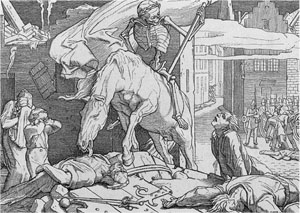3. A contemporary woodcut: “Das Ende der Revolution”, A. Rethel
 Click image to enlarge
Click image to enlarge
Questions
Geographical/Historical Context
At first, it seemed as if the insurgents in the German states could really achieve something, because many rulers firstly yielded to the pressure of the protesters and, for example, appointed liberals and nationalists for posts in their governments (e.g. Baden). On March 28, 1849, the so-called Paulskirchenverfassung (Constitution of St. Paul’s Church) was adopted, which provided for a federal state under the leadership of a hereditary emperor and a Reichstag as a legislative body. However, after the Prussian king refused the imperial crown, most of the German states withdrew their representatives from Frankfurt. Riots ignited by the supporters of the constitution were quelled.
The last revolutionaries surrendered on July 23 in Rastatt. Therefore, the constitution could never come into effect.
Alfred Rethel (1816-1859) was a German historical painter of late Romanticism.
An art historian, Richard Hamann about Rethel’s painting:
“The leader of the rebels is death himself personified as a skeleton. And death is one of the people, a wild companion - no treat for the eyes, but a necessary part of the whole. The leaflet imitates a revolutionary poster and, like every revolutionary poster, it is not supposed to convey the truth but achieve a certain effect; the actual is replaced with the radical, the real conditions with ideals. This idea […] communicates, after all, that people who fight for freedom of thought and the good conditions of work, in short, for their humanity, dig out their own grave if they fight with weapons in hand. It is a renunciation to the revolutionary optimism of the French, which, however, offers a more timely and true image of the nineteenth century.”
Answers to the questions
1. Who is depicted on the woodcut and how?
In the end, death is the victorious commander of the revolutionary conflict. He weaves his flag above the killed workers and their destroyed houses. In the background, there are soldiers standing in file.
2. What does the interpretation of the picture reveal about the course of the revolutionary events in the German states?
The revolution in the German states was suppressed by the military.




Presentation
„Auch ein Totentanz“ (1849), Zeitgenössischer Holzschnitt von Alfred Rethel (1816-1859), deutscher Historienmaler der Spätromantik.